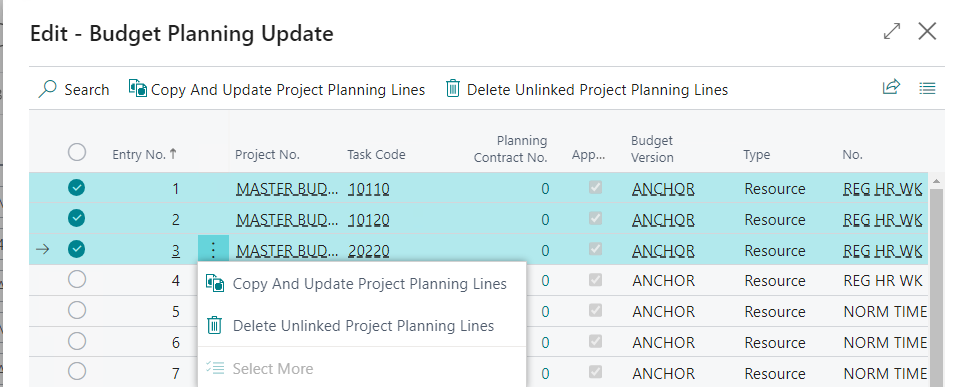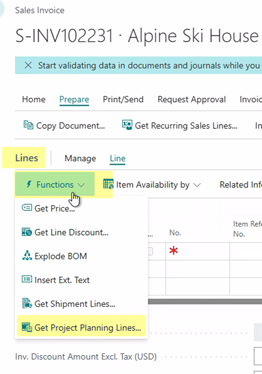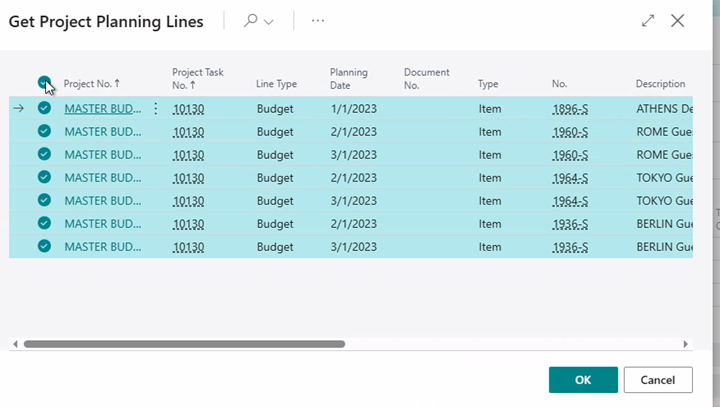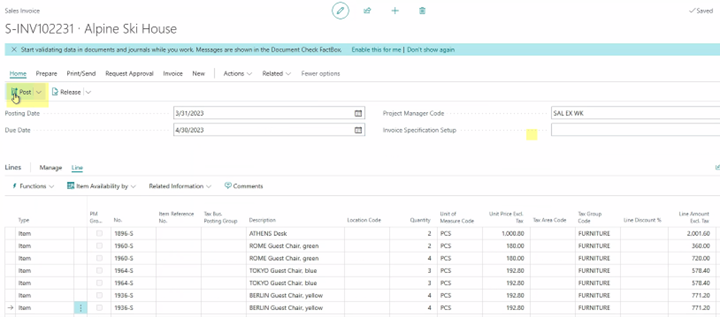What is a Reservation?
Progressus Planning Line functionality provides the ability to reserve or earmark Items for use on specific Projects. This is what is referred to as reserving or making a reservation.
What are Planning Lines?
Use Planning Lines linked to Projects to create source documents (such as creating a Purchase Order) or demand (such as creating a Sales Order) around the detailed use of Items on a Project. Planning Lines are created by using an integration feature to pull approved Project Budget Lines into the Planning Lines page. The Progressus feature is built on the standard Microsoft Dynamics 365 Business Central Planning Lines page and creates Planning Lines for a Project based on Budgets. Additional functionality allows creation, update, or deletion of Purchase Orders and Sales Orders. Additional functions link and reserve Item quantities to specific Planning Lines/Tasks in your Projects.
Setting up a Project to work with Reservations
In the Project Card > Purchasing FastTab > Purchase Receipt Posting, set the option to Inventory Reserved to Project.
In the Project Card > Related > Planning Lines page, personalize the page to add the fields Reserve, and Reserved Quantity. See: Personalize Your Workspace
Linking a Budget to Planning Lines
Running the Budget Planning Update process will take the previously entered Project Budget and create Budget Planning Lines based on that budget. If changes are made to the budget, use the Budget Planning Update process to update those budget changes into the Planning Lines.
- Select a Budget to integrate with the Planning Lines. This is done on the Project Card> Budget FastTab > Integration Planning field. This needs to be the same budget that is specified on the Project Card > Budget FastTab > Active Budget Version.
Important
The budget cannot be changed once the planning integration has been run and Planning Lines created. Once you select a Planning Integration budget in the following steps and run the Budget Planning Update, you cannot go back later and change the Budget Version used for the integration.
Navigate to the Project Plan of the Project to integrate and select Budget > Budget Planning Update
Select Copy and Update Planning Lines. This process will copy all Budget Entries to the Project Planning Lines page and removes any unlinked Planning Lines.
Tip
Individual Budget Entries can be added. Highlight a line and choose the Select More option. Mark the circle with a check at the beginning of the line to add individual Budget Entries. Unselect an entry by clicking on the circle next to it. Check the circle at the top of the column to select all entries.

You should receive a message "Copy and update has run successfully" once the process is completed.
Important
If the Project is set to Budgets require approval = enabled, and budget approvers are set up (see Budgets FastTab on the Project), budgets will not appear in the Budget Planning Update page until the budgets have been successfully approved.
Delete Unlinked Project Planning Lines
Navigate to the Budget Planning Update page from the Project Plan > Budget > Budget Planning Update.
Click Delete Unlinked Project Planning Lines to remove.
Planning Lines not linked to Budget Entries will be deleted.
Important
Planning lines with Sales Orders or Purchase Orders created will not be removed.
To review Planning Lines
Choose the relevant Project to view Planning Lines.
Select Related from the ribbon, and then Planning Lines.
Review the following fields for each Planning Line:
| Field Name | Description |
|---|---|
| Project Task No |
Specifies the number of the related Task. |
| Planning Status | Specifies the status of the Planning Line. Options are Open, Released, Order Created, or Cancel. |
| Replenishment Type | Specifies the type of supply order that is created by the planning system when the item needs to be replenished. |
| Production Order Status | Specifies the status of the production order. |
| Replenishment Doc. No. | Specifies the number of a related replenishment document such as an order. |
| Qty. On Order | Specifies the quantity on replenishment orders. |
| Remaining Qty. On Order | Specifies the number of items in the Quantity field that remain to be processed. |
| Posted Qty. On Order | Specifies the quantities on order that have been posted. |
| Bin Code | Specifies the bin where the items are picked or put away. |
Tip
Location Code field (which specifies a Location for an Item) may be added through Personalization. Location Code will be set based on value selected in job planning line once the Item is selected. If a Bin Code is not defined in the Project Task, the Default Bin Code from Project Card > Posting FastTab > Bin Code will be selected. Both values can be changed manually.
| Planning Date | Specifies the date of the Planning Line. You can use the planning date for filtering the totals of the Project, for example, if you want to see the scheduled usage for a specific month of the year. |
| Planned Delivery Date | Specifies the date that is planned to deliver the Item connected to the job Planning Line. For a Resource, the planned delivery date is the date that the Resource performs services with respect to the Project. |
| Document No. | Specifies a document number for the Planning Line. |
| Type | Specifies the type of Account to which the Planning Line relates. Options include: |
| - Resource | |
| - Item | |
| -G/L Account | |
| - Text (option is not currently used in Progressus) | |
| No. | Specifies the number of the Resource, Item or General Ledger Account (depending on the selection in the Type field). |
| Description | Specifies information about the Resource, Item, or G/L Account to which this entry applies. You can change the description. |
| Price Calculation Method | Specifies the method that will be used for price calculation in the Item Journal line. |
| Cost Calculation Method | Specifies the method that will be used for cost calculation in the Item Journal line. |
| Quantity | Specifies the number of units of the Resource, Item, or General Ledger Account for the Purchase Order or Sales Order that will be created. |
| Qty. to Assemble | Specifies how many units of the Project Planning Line Quantity to supply by assembly. |
| Unit Cost | Specifies the cost of one unit of the Item or Resource on the line. |
| Total Cost | Specifies the total cost for the Planning Line. The total cost is in the Project currency, which comes from the Currency Code field in the Project Card. |
| Unit Price | Specifies the price of one unit of the Item or Resource. Enter a price manually or use the Unit Price, based on the Price/Profit Calculation field on the related card. |
| Line Amount | Specifies the amount that will be posted to the Project Ledger. |
| Qty. to Transfer | Specifies the quantity to transfer to the Project Journal to post Usage. This quantity is adjusted to not include Usage Quantity posted from Planning Lines using a Purchase Order or a Sales Order. |
| Usage Qty. Posted | Specifies the Usage Quantity posted from Planning Lines using a Purchase Order or a Sales Order. |
| Vendor No. | Specifies the Vendor number to use when creating the Purchase Order. |
| Vendor Name | Specifies the name of the Vendor for the Purchase Order. |
| Purchase Order Action | Specifies the action to take for this line. Options include creating, updating, or deleting a Purchase Order. |
| Purchase Order No. | Specifies the Purchase Order created for this Planning Line. |
| Purchase Order Line No. | Specifies the Purchase Order line that links to this Planning Line. |
| Purchase Order Status | Specifies the current status of the Purchase Order created for this line. |
| Process Purchase Order Error | Specifies error description of why Purchase Order Action was not processed. |
| Sales Order Action | Specifies the action to take for this line. Options include creating, updating, or deleting a Sales Order. |
| Sales Document No. | Specifies the Sales Order created for this Planning Line. |
| Sales Document Line No. | Specifies the Sales Order line that links to this Planning Line. |
| Sales Document Status | Specifies the current status of the Sales Order created for this line. |
| Process Sales Order Error | Specifies error description of why Sales Order Action was not processed. |
| Customer No. | Specifies the Customer to use when creating the Sales Order. |
| Customer Name | Specifies the name of the Customer associated with the Sales Order. |
| Linked | Specifies if the job Planning Line has been successfully linked to a Budget Entry line. |
| Expense Code | Specifies the Expense code related to this line. |
| Expense Payment Type | Specifies the Expense Payment Type used to set the General Ledger Account for this line. |
Create, Update, or Delete Purchase Orders or Sales Orders from Planning Lines
Create a Purchase Order or Sales Order from a Planning Line
Select a Planning Line that was created using the previous process: Linking a Budget to Planning Lines
Select either Purchase Order Actions lookup value or Sales Order Actions, depending on whether you are working with Purchase Orders or Sales Orders.
To Create a new Purchase Order or Sales Order
For Purchase Orders:
Select a Vendor number from the lookup value on the Vendor No. field.
Select Create to create a new Purchase Order for the line.
Select Process > Process Purchase Order Actions from the ribbon.
The process will go through the Planning Lines and search for any lines with a Purchase Order Action of Create and creates a Purchase Order.
Note
For Purchase Orders, the Create process will merge any line with a Purchase Order Action of Create and the same Vendor No. value, into one Purchase Order. Each line becomes a line in the Purchase Order. Planning lines with a type of Resource are created on the Purchase Order as a G/L Account Type entry with the Resource No. field set.
For Sales Orders:
Select a Customer number from the look up value on the Customer No. field.
Select Create to create a new Sales Order for the line.
- Select Process > Process Sales Order Actions from the ribbon.
-The process will go through the Planning Lines and search for any lines with a Sales Order Action of Create and creates a Sales Order.
Note
For Sales Orders, the Create process will merge any line with a Sales Order Action of Create and the same Customer No. value, into one Sales Order. Each line becomes a line in the Sales Order.
Once you select Process Purchase Order Actions (or Process Sales Order Actions, as the case may be), the following updates are made:
Purchase orders:
The newly created Purchase Order number displays in the Planning Line Purchase Order No. field.
The Planning Line Purchase Order Line No. field is updated with the line number created on the Purchase Order.
The Planning Line Purchase Order Status field is set to Created.
Once the Purchase Order is received, the Purchase Order Status field is updated to Closed.
-
- When the Project Card > Purchase Receipt Posting field is set to “Received Not Invoiced” the Project Plan field, “Purchased Not Invoiced”, is updated with the total cost of the Items.
Sales orders:
The newly created Sales Order number displays in the Planning Lines Sales Order No. field.
The Planning Lines Sales Order Line No. field is updated with the line number created on the Sales Order.
The Sales Order Status field is set to Created.
Once the Sales Order is posted and closed, the Planning Lines Sales Order Status field is updated to Closed.
Update an Existing Purchase Order or Sales Order from a Planning Line
Select aPlanning Line that was created using the previous process: Linking a Budget to Planning Lines.
Select either Purchase Order Actions or Sales Order Actions, depending on whether you are working with Purchase Orders or Sales Orders, and select Update to update that line.
To update an existing Purchase Order:
Make a change to the Planning Line (for example, cost or price) where the Purchase Order No. shows a Purchase Order has previously been created and status is Created (you cannot update a closed Purchase Order).
Select Process > Process Purchase Order Actions from the ribbon.
The process will go through the Planning Lines and search for any lines with a Purchase Order Action of Update and will update the associated open Purchase Order with the changes you specified.
You will receive a message "Purchase Order Updated" upon successful completion of the update.
To update an existing Sales Order:
Make a change to the line (for example, price change) where the Sales Order No. shows a Sales Order has previously been created and status is Created (you cannot update a closed Sales Order).
Select Process > Process Sales Order Actions from the ribbon.
The process will go through the Planning Lines and search for any lines with a Sales Order Action of Update and will update the associated open Sales Order with the changes you specified.
You will receive a message "Sales Order Updated" upon successful completion of the update.
Delete a Purchase Order or a Sales Order from a Planning Line
- Select a Planning Line that was created using the previous process: Linking a Budget to Planning Lines and has a Purchase Order or Sales Order associated with it in the Purchase Order No. or Sales Order No. field.
Delete Purchase Orders:
- To delete an existing Purchase Order:
- From the Purchase Order Action field, select Delete to delete the Purchase Order for that line.
Select Process > Process Purchase Order Actions from the ribbon.
The process will go through the Planning Lines and search for any lines with a Purchase Order Action of Delete and will first check to see if there has been a receipt posted to the Purchase Order. If there has been a receipt posted, you will receive an error message "Purchase Order line no. xxxx cannot be deleted because it has a posted receipt". If no receipts have been posted, the process will delete the associated open Purchase Order from the Planning Line. You will receive a message "Selected Purchase Order Deleted" upon successful completion of the deletion.
- From the Purchase Order Action field, select Delete to delete the Purchase Order for that line.
Note
If the Planning Line is the only Item on the Purchase Order, the Purchase Order is deleted. Otherwise, if there are other Items on the Purchase Order, only the specified line/Item is deleted.
- To delete an existing Purchase Order:
Delete Sales Orders:
- Select Sales Order Actions lookup value.
- To delete an existing Sales Order:
- From the Sales Order Action field, Select Delete to delete the Sales Order for that line.
Select Process > Process Sales Order Actions from the ribbon.
The process will go through the Planning Lines and search for any lines with a Sales Order Action of Delete and will first check to see if there is aSales Order number in the Planning Line Sales Order No. field. If there is a Sales Order number, you will receive an error message "Sales Order field must be blank to delete the Planning Line". If the Sales Order No. field is blank, the process will delete the Planning Line. You will receive a message "Go ahead and Delete?". When you select "Yes", the Planning Line is deleted.
- From the Sales Order Action field, Select Delete to delete the Sales Order for that line.
Tip
To delete a Planning Line which has a Sales Order Number in the Planning Line, you must first delete the Sales Order in the Sales Order page. You cannot delete a line which has already been shipped. Deleting the Sales Order will remove the Sales Order number from the Planning Line and the line can then be deleted.
Get Project Planning Lines in Sales Invoice
To get Project Planning Lines from within a Sales Order, use the following steps:
Open Sales Invoices and click New to add a new Sales Invoice.

Add a Project Number to the header in the Sales Invoice.

Navigate to Lines > Functions > Get Project Planning Lines.

Use Select More to select the Project Planning Lines to add to the Sales Invoice and click OK.

Post the Sales Invoice.

Once the Sales Invoice is posted, the Project Planning Lines are updated with the Sales Invoice Number.

The Project Planning Lines can be reviewed from the Role Center > Projects - highlight the Project, then select Related > Planning Lines.

Processing
To process changes, from the ribbon select one of the following options:
Tip
If you are going to add more Planning Lines for this Project, you might consider waiting with this step until you have added all Planning Lines.
Process Purchase Order Actions: select to execute the creation, deletion, or update of Purchase Orders, based on the Purchase Order Action of the Planning Lines.
Process Sales Order Actions: select to execute the creation, deletion, or update of Sales Orders, based on the Sales Order Action of the Planning Lines.
Reservations
Reservations gives you options about how and when inventory costs are posted to the Project upon receipt of the Items and allows you to reserve Items for exclusive use by specific Projects.
To set up a Project to work with Reservations, see: Setting up a Project to work with Reservations
Options are specified in the Project Card> Purchasing FastTab > Purchase Receipt Posting:
| Field Name | Description |
|---|---|
| Received Not Invoiced |
This option that when a Purchase Order is received, no Project Ledger entries are created, and the cost is accumulated under a field Purchased Not Invoiced (LCY) in the Project Plan. This field provides visibility into these receipts that are not yet invoiced, and it indicates the Item has been received, but a Vendor invoice has not yet been received or entered. Using this option allows you to track that there is a future cost against the Project, but until the Purchase Invoice for that receipt is received from the Vendor, you do not know (or cannot enter) the actual cost. |
Note
The cost for these "purchased not invoiced" Items cannot be invoiced to the Customer on the Project until the Purchase Invoice is posted to record the cost.
| Once a Purchase Invoice is received and posted, the Project Ledger Entries are created to reverse the amount from the Purchase Order from the Purchased Not Invoiced and the Inventory Item cost is updated. |
|
| Usage Cost | Updates the Project Ledger as if this were an invoice and usage cost is updated. Purchased not Invoiced is not updated. When invoiced, an adjustment entry is made if the invoiced amount is different than the Purchase Invoice amount. This option can be used when you want to see Usage costs as soon as the inventory is received on the purchase receipt. This allows you to invoice before the Vendor invoice is created from the purchase receipt. It also allows Project reporting to include this received cost as part of the Project costs immediately. |
| Inventory Reserved to Project | No Project Ledger Entries are created. Updates inventory as normal, but the line is reserved for the Project just as if it were reserved through the Planning Lines. |
Note
Inventory Reserved to Project option requires that a budget be selected on the Project Card > Budget FastTab > Planning Integration.
To Reserve an Item
The Project Card > Purchasing FastTab settings are what determines if the Items will be reserved. The quantity is then reserved when the Purchase Order is received. Planning lines facilitate creating the Purchase Order.
To use Progressus functionality to create a reservation on a Planning Line, using purchased Items, use the Purchase Order Action field option Create or Update to either create a new Purchase Order or update an existing Purchase Order for the Planning Line.
To reserve Items to a Project from already existing inventory, use the Sales Order Action functions of Create or Update to either create a new Sales Order (create), or update an existing Sales Order for the Planning Line.
Note
If the Project Card > Purchasing FastTab > Purchase Receipt Posting option is set to Inventory Reserved to Project, if you use the Planning Lines Purchase Order Action > Create to create a new Purchase Order, once the Purchase Order is received, the quantity received displays in the Planning Lines Reserved Quantity field (you may wish to add this field to the page using Personalization). See: Personalize Your Workspace
To cancel a reservation
Navigate to the Project Plan and select Related > Planning Lines from the ribbon.
In the Planning Lines page that displays, highlight the line which contains the reservation you wish to cancel.
In the ribbon, select the ellipsis to open Related > Planning Line > Reservation Entries to open the Edit - Reservation Entries - Planning Line page.
In the Edit - Reservation Entries - Planning Line page, with the reservation line highlighted that you wish to cancel, select Cancel Reservation from the ribbon.
Click Yes to message 'Cancel reservation of 'x' of Item number 'yyyy', reserved for Project 'ZZZZZZ' from Purchase Order "xxxxxx'? to complete cancellation of the reservation.
To View Reservations on an Item
To see which Projects for which an inventory Item is reserved:
Navigate to the Item Ledger Entries page.
Locate the Item No. field in the ribbon.
Locate the Item you wish to view.
Tip
You can use the Search feature in the ribbon or click the Open Menu lookup and select Sort Ascending or Sort Descending to make it easier to find the Item.
Highlight the desired Item, and from the Open Menu lookup, select Filter to this Value.
To view the Project or Task number that the Item is related to, you may need to personalize the page and add the Project No. and Project Task No. fields. See: Personalize Your Workspace
Videos
B&R 4 - Budgets & Reservations - Creating Job Planning Lines
B&R 5 - Budgets & Reservations - Updating Job Planning Lines
B&R 6 - Budget & Reservations – Using Job Planning Lines with Purchasing
B&R 7 - Budget & Reservations - Purchase Receipt Posting – Received Not Invoiced option
B&R 8 - Budget & Reservations - Purchase Receipt Posting – Usage Cost Option
B&R 9 - Budget & Reservations - Purchase Receipt Posting – Inventory Reserved to Project Option
B&R 10 - Budget & Reservations - Purchase Receipt Posting How to “Update” costs on Unposted Receipts